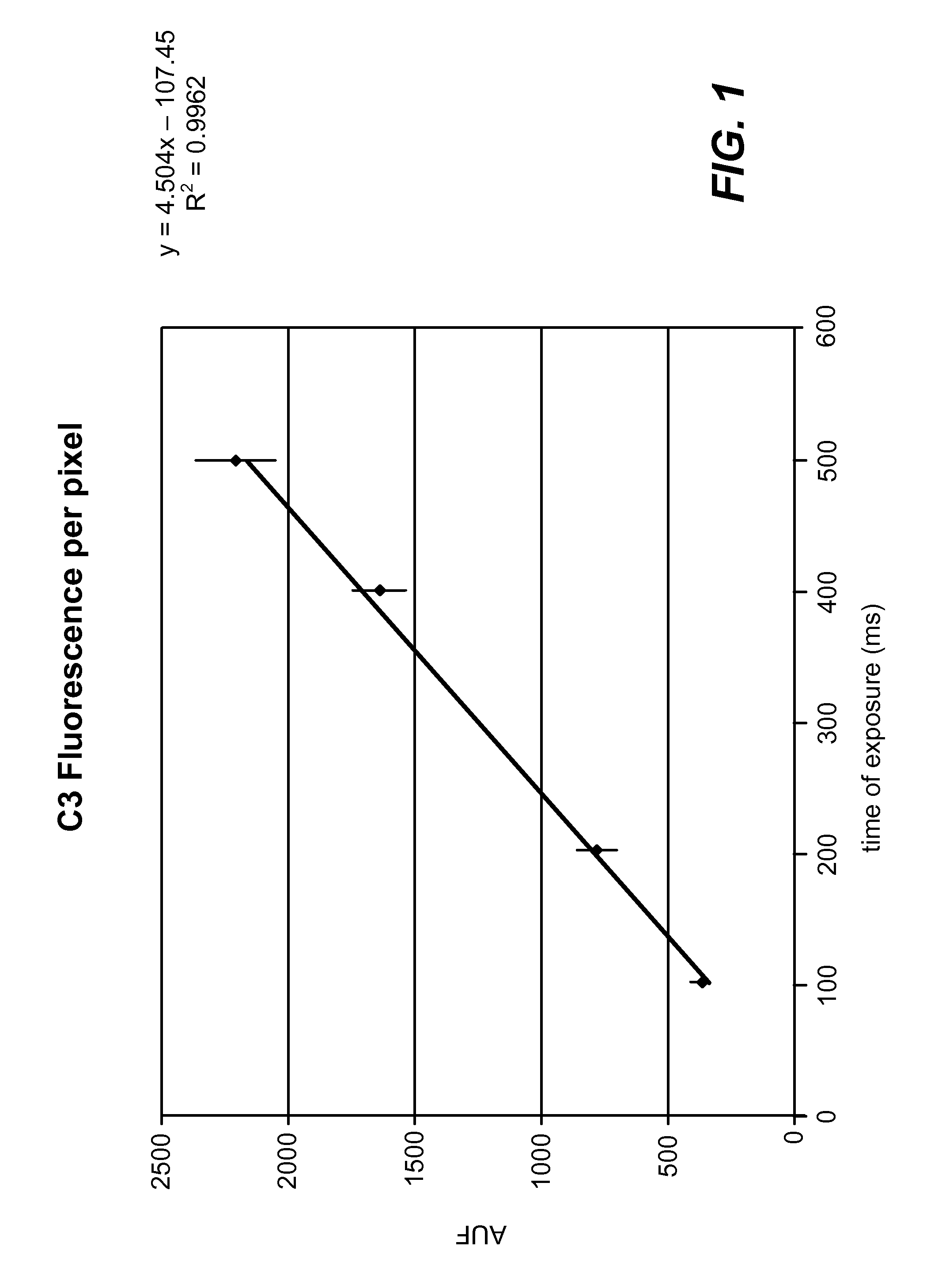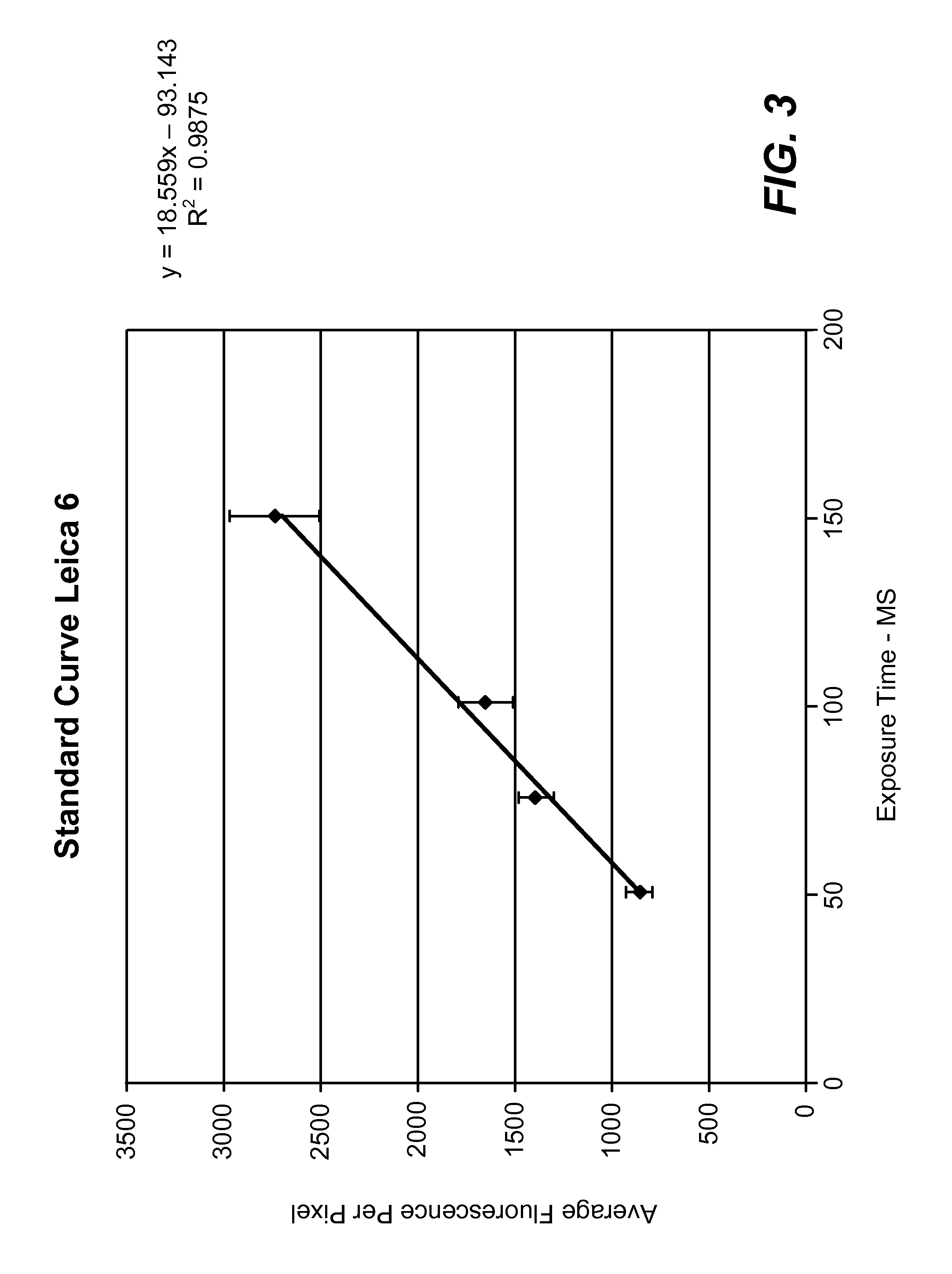Standardized evaluation of therapeutic efficacy based on cellular biomarkers
a cellular biomarker and clinical trial technology, applied in the field of pharmaceutical therapies, can solve the problems of undesirable side effects, potentially a significant opportunity loss of therapy, and the addition of toxic side effects to all patients, so as to reduce the amount of a particular biomarker, increase fluorescence, and increase the effect of fluorescen
- Summary
- Abstract
- Description
- Claims
- Application Information
AI Technical Summary
Benefits of technology
Problems solved by technology
Method used
Image
Examples
example 1
[0023]Initially, an attempt to obtain the desired results using the obvious approach, and the failure of that approach, will be described.
[0024]A fluorescence microscopy standard (4.0 rim-diameter microspheres, Kit M-7901 from Molecular Probes) was used to calibrate two different Leica microscopes. Standard curves of fluorescence per pixel (average of about 20 microspheres at each time point) versus exposure time in milliseconds were constructed (see FIG. 1 and FIG. 2). A linear response is observed with both microscopes over the range of exposure time used to acquire images.
[0025]A breast cancer cell line, HCC 2218 (positive for HER2 / neu expression) was stained simultaneously with anti-cytokeratin-FITC and anti-HER2 / neu-Alexa 532 (red fluorescence) antibodies. Digital images were acquired of identical fields using filter cubes that differentiate the two fluorescence signals. The HER2 / neu images were acquired using exposure times within the linear range of the standard curves, viz.,...
example 2
[0027]It was then determined that the desired consistency of results could be achieved by the following method.
[0028]An antibody specific for the receptor is labeled with fluorescent dye and a fluorescence standard has been obtained for the generation of standard curves to allow HER2 / neu fluorescence to be normalized as a percentage of the non-bleaching standard. HER2 / neu values can then be correlated from sample to sample and from laboratory to laboratory based on quantitative calibration on a universal fluorescence standard.
[0029]A fluorescence microscopy standard (4.0 um-diameter microspheres, Kit M-7901 from Molecular Probes) was used to calibrate two different Leica microscopes. Standard curves of fluorescence per pixel (average of about 20 microspheres at each time point) versus exposure time in milliseconds were constructed (see FIG. 3 and FIG. 4). A linear response is observed over the range of exposure time used to acquire images. From these linear curves, an exposure time ...
example 3
[0032]Cells: Six breast cancer cell lines were purchased from ATCC and grown in medium containing 10% fetal bovine serum. HCC2218, HCC38, HCC2O2 and T-47D were grown in RPMI 1640, MCF-7 was grown in EMEM and SK-BR-3 was grown in McCoy's. Exponentially growing cells were trypsinized and spun onto microscope slides from a megafunnel with a Cytospin 3 (Shandon) at 1000 rpm for 10 minutes and then air-dried for at least two hours, preferably overnight.
[0033]Reagents: An antibody cocktail for identifying epithelial cells containing monoclonal antibodies covalently labeled with FITC and which recognizes nine different cytokeratin peptides and a tumor-associated glycoprotein. Anti-ERCC-1 (sc-10785, Santa Cruz Biotechnology), anti-thymidylate synthase (clone TS 106, Exalpha Biologicals), anti-estrogen receptor (clone TE 111 .5D 11, Exalpha Biologicals) and Trastuzumab (Genentech) were conjugated to Alexa Fluorescent (AF) dyes AF 594, AF 647, AF 594 and AF 532 (Molecular Probes, Eugene, Oreg...
PUM
| Property | Measurement | Unit |
|---|---|---|
| exposure time | aaaaa | aaaaa |
| exposure time | aaaaa | aaaaa |
| fluorescent microscope | aaaaa | aaaaa |
Abstract
Description
Claims
Application Information
 Login to View More
Login to View More - R&D
- Intellectual Property
- Life Sciences
- Materials
- Tech Scout
- Unparalleled Data Quality
- Higher Quality Content
- 60% Fewer Hallucinations
Browse by: Latest US Patents, China's latest patents, Technical Efficacy Thesaurus, Application Domain, Technology Topic, Popular Technical Reports.
© 2025 PatSnap. All rights reserved.Legal|Privacy policy|Modern Slavery Act Transparency Statement|Sitemap|About US| Contact US: help@patsnap.com



